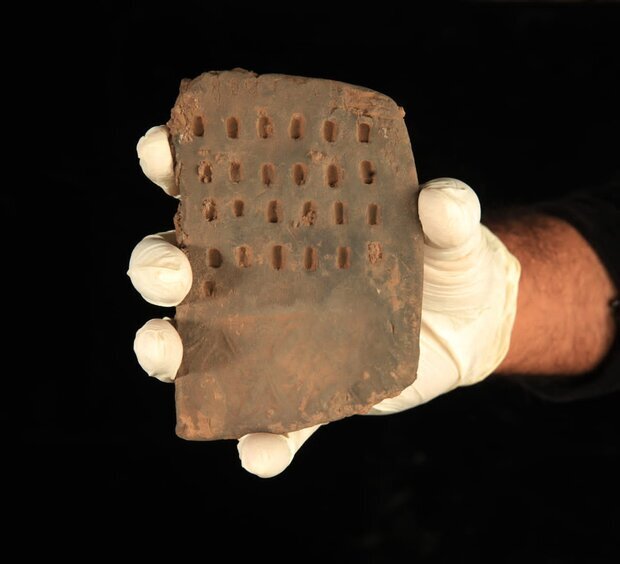Elamite clay tablet unearthed in mysterious Burnt City

TEHRAN – A team of Iranian, Italian, and Serbian archeologists has unearthed an Elamite clay tablet inside the Burnt City, a rare discovery that gives subtle clues about the interaction between the eastern and western sides of the Iranian plateau during prehistorical times.
The discovery of such [clay] tablets is not bizarre in the western regions of Iran but the point is that archaeologists have never made such a unique discovery in the easternmost point of the Lut Plain and southeastern Iran, senior Iranian archaeologist Seyyed-Mansour Seyyed-Sajjadi said on Thursday.
Called “Shahr-e Sukhteh” in Persian, the UNESCO-registered Burnt City is associated with four rounds of civilization, all mysteriously burnt down by catastrophic sets of fire. It is situated in Sistan-Baluchestan province, which was once a junction of Bronze-Age trade routes crossing the semi-arid plateau.
Elaborating on the significance of the discovery, Seyyed-Sajjadi who leads the current excavation on Burnt City, said: “It is the first time that such a significant clay tablet which is an accounting document has been discovered in Shahr-e Sukhteh since 50 years ago when the site underwent archaeological excavation for the first time.”
Measuring 11 by seven centimeters, the tablet was found by archaeologist Hossein Moradi some four meters below the surface in the Room 27th of a once residential area, Seyyed-Sajjadi explained.
“The clay tablet bears some signs some of which depict the types and quantity of shipped goods… it also has signs that are still unfamiliar for us.”
Arrays of animal and human figurines are amongst other relics discovered recently during the 19th season of archaeology that commenced on November 19 on the magnificent site.
The figurines include various animal designs, especially cows, as well as human statues, which are in the form of sitting women and standing men. Moreover, a kiln has been unearthed as well. However, it is not yet determined to be a pottery oven or a metal smelting furnace, according to Seyyed-Sajjadi.
“So far, four to five percent of Burnt City has been excavated. . . and [conducting surveys on] unexplored areas require a lot of time and funds,” according to provincial tourism chief Alireza Jalalzaei.
“In this season of excavation, residential areas in the central and eastern parts [of Shahr-e Sukhteh] are to be explored. “The excavation season is estimated to take 60 days, of which 45 days are for field activities and 15 days for summarizing field information, preparing reports, and sending to the Research Institute [for Cultural Heritage and Tourism],” Jalalzaei says.
Furthermore, archaeologists have already discovered the remains of a prehistoric monkey in Burnt City, concluding that the animal was held in captivity in a cage when it died. Based on surveys and scientific studies on the monkey’s skeleton, the animal was dead in captivity in a cage and it was buried by its owner like a child within a beautiful container, according to Seyyed Sajjadi.
“Since the Burned City had lots of commercial relations with the eastern territories of Iran such as northern India and central Asia, and there is a lot of information in this regard, we found that the monkey came from there.”
“The other issue is that in the ancient world, monkeys were essentially regarded as a luxury and aristocratic belongings. And they were imported to be presented to people of certain social classes such as elites, merchants, governors, and religious authorities,” Seyyed Sajjadi explained.
Founded around 3200 BC, Burnt City was populated during four main periods up to 1800 BC. Previous rounds of excavations showed that its residents had great skills in weaving, creating fine arts such as decorative objects, stone carving, and pottery painting.
Situated in a region inside the modern-day provinces of Ilam and Khuzestan, Elam was one of the most impressive civilizations of the ancient world. It was never a cohesive ethnic kingdom or polity but rather a federation of different tribes governed at various times by cities such as Susa, Anshan, and Shimashki until it was united during the Middle Elamite Period, briefly, as an empire.
The name Elam was given to the region by others – the Akkadians and Sumerians of Mesopotamia – and is thought to be their version of what the Elamites called themselves – Haltami (or Haltamti) – meaning “those of the high country”. 'Elam', therefore, is usually translated to mean “highlands” or “high country” as it was comprised of settlements on the Iranian Plateau that stretched from the southern plains to the elevations of the Zagros Mountains.
Elamite language, extinct language spoken by the Elamites in the ancient country of Elam, which included the region from the Mesopotamian plain to the Iranian Plateau. According to Britannica, Elamite documents from three historical periods have been found. The earliest Elamite writings are in a figurative or pictographic script and date from the middle of the 3rd millennium BC.
AFM
